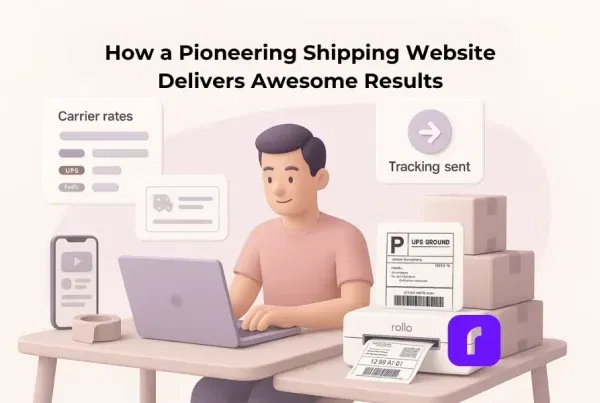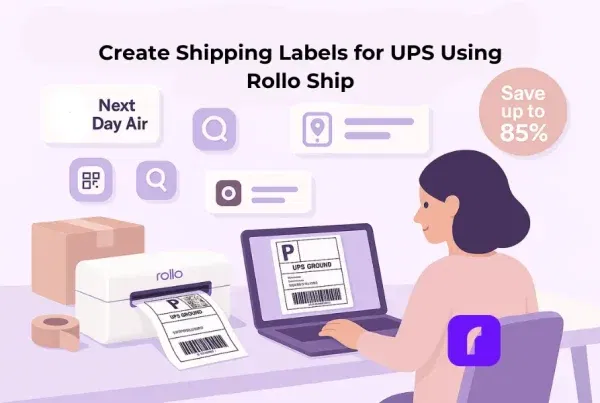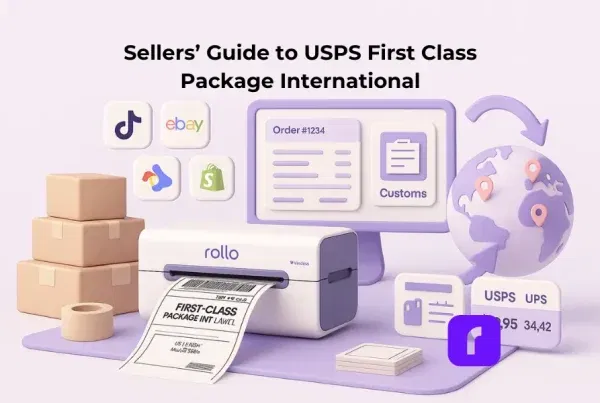Ever tried to print an Amazon shipping label right before your pickup deadline—only to watch the label portal spin, your printer jam, and a “tracking number already used” error pop up? If you’re shipping dozens or even hundreds of orders a week, that tiny hiccup can snowball into missed scans, angry customer messages, and wasted hours you never budgeted for. This guide breaks down the smartest way volume sellers streamline label creation, avoid surprise costs, and keep fulfillment running on schedule — all while using tools that make the job feel almost effortless.
Table of Contents
What Is an Amazon Shipping Label? — And Why Does It Matter?

An Amazon shipping label is the 4 x 6‑inch barcode tag Amazon requires on every outbound package so its network (and your customer) can track the parcel from your door to theirs. Get it right and your package sails through carrier hubs, updates tracking in minutes, and protects your on‑time delivery rate. Get it wrong and you risk FBA check‑in delays, “item not received” claims, or suspension warnings that hit seller metrics where it hurts. If you’re new to selling on Amazon or want to optimize your store setup, check out our guide to selling on Amazon for practical tip
How to Create and Print Amazon Shipping Labels

A smooth workflow cuts label time from minutes to seconds. Follow these four essential steps to create and print Amazon shipping labels quickly and accurately.
Log In and Select Orders
In Seller Central, go to Manage Orders, filter by “Unshipped,” and tick the boxes for every order you’re packing today. Filtering orders this way ensures you don’t miss shipments and helps streamline your pick-pack process.
Click “Buy Shipping” and Verify Details
Amazon auto-fills the buyer’s shipping address, but it’s crucial to double-check package weight and size. Mistakes here can lead to costly dimensional surcharges or failed label generation. Always confirm the shipping details match your actual package dimensions.
Choose Your Carrier Service and Format
For most sellers, a 4 x 6 thermal PDF label works best. This format is compatible with thermal printers and is Amazon’s recommended size. Select your preferred carrier—USPS, UPS, or Amazon Shipping—and click “Purchase” to generate the label.
Print Your Amazon Shipping Label
Use a wireless thermal printer, like Rollo’s, to print a crisp label in about a second without ink or toner. If Amazon throws an error during label generation, refresh the page, clear your browser cache, or try again in an incognito window. These quick fixes resolve over 90% of common label issues. For a deeper dive into Amazon label types and requirements, see our full Amazon labels explained guide.
Common Amazon Shipping Label Problems and Quick Fixes

Even experienced Amazon sellers run into frustrating shipping label issues. Here are some of the most common problems—and how to fix them fast.
FBA Label Generation Errors
Sometimes, Amazon’s system refuses to generate FBA shipping labels, leaving your orders stuck. If this happens, try switching to a different browser or waiting ten minutes. Amazon’s bulk servers often clear themselves. For urgent restocks, you can generate Merchant Fulfilled labels first, then convert those orders back to FBA once the glitch resolves.
USPS Refuses Amazon-Paid Labels
A few sellers report local USPS branches rejecting Amazon-paid labels, often due to confusion over payment validity. The fix? Hand the clerk the latest USPS bulletin confirming that Amazon’s prepaid postage is accepted. Most rejections are simple misunderstandings, not policy issues.
Tracking Numbers Show Incorrect Deliveries
If a tracking number shows a package as “delivered” to the wrong state, it’s likely a recycled tracking issue. Void the label, purchase a new one, and message the buyer preemptively. Clear communication can prevent negative feedback or refund requests.
Multi-Channel Orders Require Separate Logins
Managing orders across Amazon, Etsy, Shopify, and other platforms can lead to login fatigue and manual errors. Use an integrator like Rollo Ship to pull all orders into one dashboard. You can batch-print up to 100 shipping labels at once, saving time and reducing mistakes.
Why Thermal Printers Beat Desktop Inkjets for Volume Sellers

Inkjet sheets work if you ship once a week. High‑volume operations need thermal printers because they’re:
- 🚀 Faster. Up to 150 mm/s—roughly one label per second—so pick‑pack stations don’t bottleneck.
- 💰 Cheaper long‑term. Thermal printers use heat‑sensitive paper, so you’ll never buy ink or toner again.
- 🧼 Cleaner. No smears, clogs, or head‑alignment headaches.
- 🔄 Flexible. Many models auto‑calibrate between 4 x 6 shipping labels and 2.25 x 1 FBA barcodes.
Rollo’s wireless thermal printer adds Wi‑Fi and AirPrint, which means you can print labels straight from a phone at the packing table. Pair it with FSC‑certified, BPA‑free labels and you’ve got eco‑friendly packaging that still sticks tight in humid warehouses.
Streamlining Fulfillment with Rollo Ship

Printing fast is only half the battle; you also need to buy the right postage at the lowest rate. Rollo Ship syncs your Amazon account (plus eBay, Etsy, and Shopify) so you can:
- 🔎 Compare USPS and UPS rates side by side. No more instinct‑based guessing.
- 🖨 Batch‑print up to 100 labels at once. One click, one PDF, done.
- 📧 Auto‑email tracking numbers. Buyers get updates before they can ask, which slices “Where’s my order?” tickets.
- 💸 Access pre‑negotiated discounts. Many users save 15–20 % on Priority and Ground shipments right out of the gate.
- ✅ The result? Fewer tabs, fewer mistakes, more time to focus on listing new products or tweaking ads.
How Much Do Amazon Shipping Labels Cost?

Label fees depend on three factors: carrier, service speed, and dimensional weight. A 12‑ounce First‑Class parcel can run as low as \$3.80, while a two‑pound Priority Mail box may cost \$8–10. UPS Ground might beat both for zones 4–8. To keep costs predictable:
- 📦 Trim dead space in boxes. Smaller packages drop weight tiers.
- 📏 Use cubic pricing where possible. Priority Mail Cubic often undercuts standard rates for dense items.
- 🔍 Compare real‑time. Rollo Ship’s rate table shows you the cheapest option before you click “Buy.”
No Printer? Temporary Solutions Until You Upgrade
You can download the PDF to your phone and print at a library, UPS Store, or USPS self‑service kiosk—but each trip steals minutes from your day. Long term, the \$259 price tag on a wireless thermal printer pays for itself in ink savings, speed, and sanity within a couple of months.
Final Words
Mastering your Amazon shipping label workflow isn’t just a nice‑to‑have—it’s the backbone of fast, reliable fulfillment. By switching to a wireless thermal printer, trimming label errors, and tapping an integrated tool like Rollo Ship, volume sellers gain three priceless advantages: speed, accuracy, and lower costs. Fewer jams and recycled tracking numbers mean happier customers and stronger seller metrics, while batch‑printing and built‑in rate comparisons free up time to focus on growth.
If you’re ready to turn label printing from a daily headache into a one‑click routine, Rollo’s wireless printer and Rollo Ship platform are built for you. Upgrade today, streamline tomorrow, and watch your fulfillment flow run smoother than ever.
Follow Rollo on:
Frequently Asked Questions About the Amazon Shipping Label
📌 Q: Is an Amazon return label free?
💭 A: Sometimes. If the return falls under Amazon’s “Free Returns” policy, you pay nothing. Otherwise, the return shipping fee is deducted from your refund or charged to your account.
📌 Q: Can USPS print my Amazon shipping label?
💭 A: Most branches can’t. You’ll need to arrive with the label printed, or use Amazon’s QR code option at participating locations, where a clerk prints the label at the counter.
📌 Q: What size should an Amazon shipping label be?
💭 A: Amazon recommends a 4 x 6‑inch label for packages and a 2.25 x 1‑inch FBA barcode for individual units. Both fit perfectly on standard thermal rolls.
📌 Q: Why won’t Amazon let me print my shipping label?
💭 A: The most common culprits are browser cache issues, expired sessions, or temporary server outages. Refresh, clear cache, or retry in a private window before contacting Seller Support.
📌 Q: How do I print labels faster without extra staff?
💭 A: Use a wireless thermal printer and an integrator like Rollo Ship to batch orders. Most sellers cut label prep time by over 50 % in the first week.


